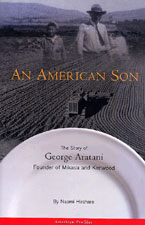|
How the son of a prosperous California farmer used his Japanese contacts to build Mikasa and Kenwood. Brings to life the unique place Japanese Americans occupy in California history. |
CONTACT US
|
ADVERTISING INFO
© 1996-2013 Asian Media Group Inc
No part of the contents of this site may be reproduced without prior written permission.
GOLDSEA | ASIAN BOOKVIEW | NONFICTION
An American Son
a biography of George Aratani
Japanese American National Museum, 2001, 321 pp
EXCERPT:
 trangers don't travel to Guadalupe, and if they happen to stop, they don't stay for long. There's no hotel in this California seaside town located 170 miles north of Los Angeles, and there's barely any mention of it in any tourist book. Of course, there are those who are drawn to such places, those who seek out historic spots lacking neon or fancy signs which contain clues to buried stories. Guadalupe's modest cemetery, surrounded by an iron fence, is one such spot.
trangers don't travel to Guadalupe, and if they happen to stop, they don't stay for long. There's no hotel in this California seaside town located 170 miles north of Los Angeles, and there's barely any mention of it in any tourist book. Of course, there are those who are drawn to such places, those who seek out historic spots lacking neon or fancy signs which contain clues to buried stories. Guadalupe's modest cemetery, surrounded by an iron fence, is one such spot.

The graves of Swiss Italians, Portuguese, and Irish date back to the nineteenth century. A large section of the cemetery, maybe one quarter of its area, has granite headstones marked with such names as Ito, in both cursive Japanese kanji characters and English. Among them is a large, simple tombstone with these names: "Setsuo Aratani, 1885-1940," and "Yoshiko Aratani, 1889-1935."
At one time, before World War II, Japanese farmers dominated this region. There were the Big Three -- Aratani, Minami, Tomooka -- Japanese immigrants who tilled thousands of acres of farmland and harvested tons of carrots, lettuce, peas, and chili peppers; the produce was packed in ice and shipped as far as Texas and the East Coast. In town, boardinghouses were full of bachelors from Hawai'i, their lower arms and faces tanned dark as molasses. Country wives fermented boiled rice in wide, wooden barrels to produce powerful wine for their husband and friends.
Today, little evidence remains of all this activity. Guadalupe Boulevard, the town's main drag, reveals only remnants of a heyday gone by. Everyone knows the local police chief and the former mayor, who helps operate an ice factory that stands next to the former site of the Guadalupe Produce packing shed.
[CONTINUED BELOW]
Before the arrival of the Big Three farmers, Chinese laborers, hoes in hand, broke the arid ground and planted sugar beets for the Union Sugar Mill in Betteravia, established in 1899. "All that's left of that era is a line of old tin buildings," explains Jose Rubalcaba, the co-founder of the Rancho de Guadalupe Historical Society.
Jose, who is past 70, is the resident historian, with keys to all the important spots in town. He unlocks an old adobe jail that his group has restored and proudly points to bricks with donors' names at the top of the building. Later he guides us into the empty senior citizen center, where he takes from his briefcase colorful crate labels touting "Home Run King" and "All Star" vegetables. "These came from Guadalupe Produce," he says, "Aratani's place."
All the old-timers know of Setsuo Aratani and his son George. Of the Big Three farmers, Setsuo was probably the most ambitious. He began one of the first packing operations, and he always thought big. He diversified his crops and his businesses, dabbled in the sale of sake (rice wine), from his hometown, and he launched a hog farm, a chili dehydrating plant, and a fertiliser plant, as well as investing in a wholesale produce market in Los Angeles.
While other farmers had wood-framed homes with peeling paint battered by the weather, Setsuo resided in a Spanish-style house complete with a Japanese garden and goldfish pond. He was known as "Ace", both for his golfing and poker expertise. He played with the Japanese and he played with European Americans, and his passion for sports was infectious. Soon the whole town was baseball crazy, and everyone participated in golf tournaments held at the Santa Maria Country Club. For two decades in Guadalupe, the town -- at least superficially -- disregarded color barriers and joined together for picnics where Japanese, European Americans, Mexicans and Filipinos sat together to eat mesquite barbecue and watch performances by locals.
